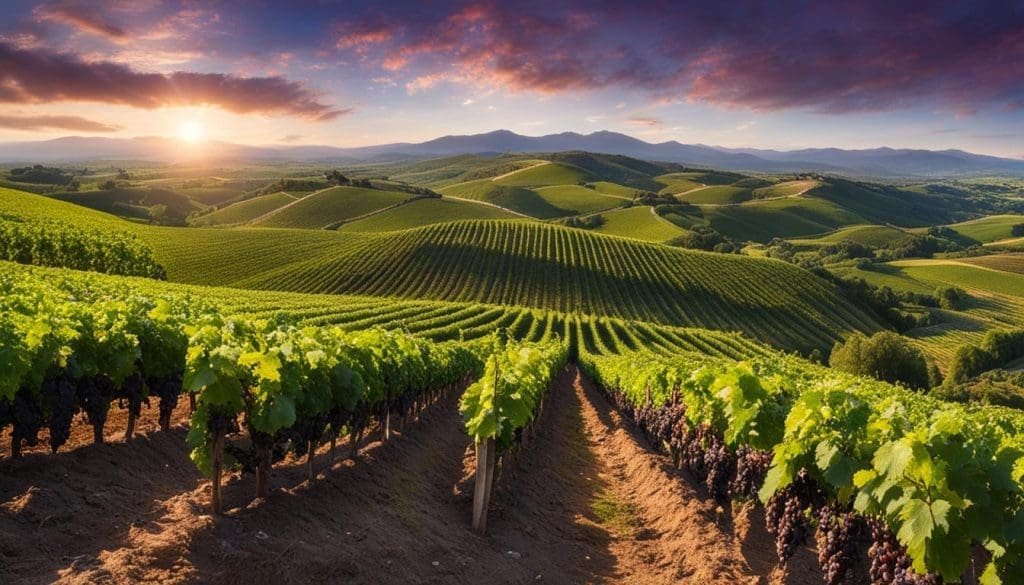This post may contain affiliate links. Please read my disclosure policy.
If you’re looking to savour a taste of Italy’s prestigious winemaking history, look no further than the esteemed Aglianico grape variety. Adored by ancient Roman culture, this noble red wine boasts an illustrious past that stretches from the rolling hills of the Campania region to the renowned Taurasi DOCG zone. Throughout the journey of this exquisite varietal, you’ll discover the rich legacy that cements its status as one of Italy’s finest wines, not only due to its historical roots but also its intricate cultivation methods and unique flavour profiles.
Key Takeaways
- Aglianico is a noble red wine with deep ties to ancient Roman culture and the Campania region of Southern Italy.
- Taurasi DOCG is a notable area in the Campania region that highlights Aglianico’s rich and flavourful characteristics.
- A blend of complex fruit and aromatic flavour profiles sets Aglianico apart, including plum, red cherry, fig, pepper, and cacao notes.
- The unique Italian terroir, steeped in volcanic soils, contributes to the aromatic and taste profiles of Aglianico wines.
- From vine to bottle, meticulous viticulture practices and skilled artisanship shape the final taste of Aglianico wines.
An Introduction to Aglianico: A Historical Perspective
Tracing its origins back to the ancient Phoenicians, the Aglianico grape has a storied past that has evolved over centuries. Its historical journey includes both Greek and Roman influences, who recognised the value of this prized grape and cultivated it extensively.
- Phoenician Origin: The Aglianico grape is believed to have been brought to Southern Italy by the Phoenicians, a maritime trading culture from the eastern Mediterranean region who introduced the grape to ancient Greek colonies.
- Greek Influence: The Greeks played a significant role in the development of the Aglianico grape, as they continued to cultivate and refine the varietal to suit their tastes. This led to further integration of the grape into their culture, contributing to its enduring nature.
- Roman Appreciation: Already revered by the Greeks, the Romans recognised the grape’s distinctive qualities, encouraging its cultivation throughout their trade routes across the vast Roman Empire. Used in religious ceremonies, personal consumption, and military rations, Aglianico gained a strong foothold in Roman society.
Labelled a hidden gem in the modern era, Aglianico’s legacy, compared to global contemporary rivals like Sangiovese and Nebbiolo, echoes its rich past in today’s wine culture.
Spanning a rich history and the rise and fall of ancient empires, the Aglianico grape has navigated the shifting tides of time. In fact, its story of resilience and rebirth has become a symbol of the triumph and evolution of Italian wine culture overall.
| Ancient Civilisation | Role in Aglianico History |
|---|---|
| Phoenicians | Introduced Aglianico to Southern Italy and Greek colonies |
| Greeks | Refined and developed the Aglianico cultivar |
| Romans | Expanded cultivation and integrated Aglianico into various aspects of society |
Aglianico’s historical legacy is still alive and well today, with the varietal flourishing around the world and garnering recognition among wine enthusiasts for its unmatched complexity and depth. A genuine tribute to ancient wine culture, Aglianico remains a testament to the ever-evolving world of viticulture and the power of preserving tradition for future generations.
Taste Profile and Sensory Experience of Aglianico
The Aglianico wine possesses a distinct sensory experience, intricately woven by unique primary flavours and taste characteristics. For those appreciative of its intricate depth, every sip tantalises the palate with a symphony of vibrant and subtle notes.
Primary Flavours and Aromas
For the seasoned enthusiast, Aglianico reveals a vivid palette of fruit notes, including bold profiles of plum, red cherry, and fig. These intensity of fruit flavours is balanced by intriguing hints of red and black pepper, cacao, and mushroom. To further complement this rich tapestry, a subtle brightness of tomato and limestone minerality emerge, adding an additional layer of complexity to the sensory experience.
The Impact of Ageing on Flavour Development
Aglianico undergoes a remarkable transformation as it matures, with the ageing process playing a pivotal role in moulding its flavour development and tannic structure. The wine begins as an intense, tannin-rich drink which mellows into a more balanced, rounded profile as time progresses. This metamorphosis is further shaped by the oak influence. Regulations, such as Taurasi DOCG’s mandatory 3-year ageing period (including one year in oak barrels), and reserve Taurasi reds’ requirement for a minimum of 4 years, are testament to the importance of ageing in cultivating an Aglianico’s signature tasting experience.
Serving Aglianico: Temperature and Decanting Guidelines
Ensuring the optimal sensory journey with Aglianico demands attention to specifics in serving temperature and decanting time. The ideal temperature in Celsius depends on the age and style of the wine. Generally, younger Aglianico wines benefit from serving at around 16-18°C, while older, reserve Taurasi reds are best enjoyed at 18-20°C. To further enhance the tasting experience, consider serving the wine in appropriate glassware that allows the bouquet and flavours to fully evolve.
Decanting Aglianico delivers ample aeration for the wine, softening its initial bold tannic structure and coaxing out more nuanced flavours. For an optimal tasting experience, younger wines typically require 2 to 3 hours of aeration, while older, more complex wines may necessitate 4 to 6 hours of decanting.
With these factors in mind, savouring Aglianico as it is meant to be experienced becomes a cherished journey for the senses – a testament to the grape’s rich lineage and the mastery of its creators.
The Italian Terroir: How Soil and Climate Shape Aglianico
The Italian terroir plays an intrinsic role in shaping the characteristics of the Aglianico grape variety. This grape thrives in the unique soil and climate conditions found in regions such as Campania and Basilicata, where Aglianico wines are lauded for their remarkable taste and structure.

The minerality and complexity of Aglianico wines can be largely attributed to the terroir, which includes volcanic soils rich in nutrients, sun-exposure, and well-drained slopes that encourage deep root growth. Such ideal conditions help to mould the grapes into distinctive wines with outstanding potential for long-term aging.
Regional influences also play a significant part in the profile of Aglianico wines, as the climates in areas such as Vulture and Taurasi provide variation in temperatures to further develop the flavours and aromatics of the grape.
“Volcanic soils and unique regional climates contribute immensely to Aglianico’s distinct profile and characteristics.”
Climate for Aglianico
Aglianico is known for its late-ripening nature, which directly impacts the wine’s flavors and overall structure. The optimal climate for Aglianico accounts for an extended growing season, characterised by warm, sunny days and cool nights. This diurnal temperature variation helps the grapes develop balanced sugar levels, vibrant acidity and well-rounded tannins.
Soil Conditions for Aglianico
Aglianico’s taste and aroma profile are deeply influenced by the region’s mineral-rich volcanic soils. These soils offer a blend of essential nutrients, enabling the vines to produce grapes with pronounced fruit flavors and mineral complexity.
Some of the key soil components that enhance Aglianico’s profile include:
- Clay – offers good water retention and contributes to tannin structure
- Basalt – volcanic rock imparts mineral complexity to the wine
- Tuff – porous volcanic stone provides excellent drainage and oxygenation
- Limestone – imparts bright acidity and fresh minerality
Many Aglianico vineyards are carefully planted on slopes where proper drainage and air circulation can be attained, ensuring the longevity and overall quality of the wines produced.
Expert Vineyard Management
Managing the conditions of the vineyards is a vital aspect of the winemaking process. Vineyard managers working with Aglianico have adapted various techniques to ensure the health and quality of the vines, including monitoring sun exposure, optimising air circulation, and proper soil management.
Through painstaking effort and adherence to the idiosyncrasies of the grape variety, winemakers are able to maximize the potential of the Aglianico grape in its native Italian terroir. It is these distinct conditions, soil composition, and regional influences that ultimately bestow the noble Aglianico wine with its unparalleled taste and aromatic profile.
From Vine to Bottle: The Art of Crafting Aglianico
The process of crafting Aglianico is a meticulous journey from the vineyard to the bottle. Viticulture practices, such as trellising, pruning, soil management, and harvest timing, are instrumental in capturing the unique taste and aroma of the grape variety. This section explores how these factors influence Aglianico’s full-bodied and dry profile and how two commonly used trellising systems, Guyot and Spur Cordon, contribute to the art of crafting this noble red wine.
Selecting the trellising system is a crucial decision that directly impacts vineyard management, overall health of the vines, and ultimately the quality of Aglianico wine. The Guyot and Spur Cordon systems are two popular methods that cater to the precise pruning needs of Aglianico grapes.
The Guyot system involves retaining one or two long canes and removing most of the previous year’s growth. The Spur Cordon system retains short, permanent “arms” or cordons along the length of the trellis, with spurs pruned back to the desired number of buds each year.
Pruning is another viticultural practice that plays a significant role in cultivating Aglianico grapes. It is vital for controlling vine growth, balancing fruit production, and maintaining vine health. Pruning methods differ based on factors such as vine age, desired yields, and trellising system used.
A significant aspect of Aglianico cultivation is soil management, encompassing practices like irrigation, fertilization, and pest control. Aglianico grapes thrive in well-drained soils, rich in minerals and with the ability to retain moisture. Manageable canopy growth and adequate air circulation are essential to prevent disease and ensure healthy grape development.
The last pivotal factor in crafting Aglianico is harvest timing. Since Aglianico grapes are late-ripening, vineyard managers must be vigilant in monitoring factors such as sugar levels, phenolic ripeness, and general grape health to determine the optimum time for harvesting.
| Viticulture Practice | Impact on Aglianico Grapes |
|---|---|
| Trellising System | Controls vine growth, manages sunlight exposure, and influences fruit production |
| Pruning | Maintains vine health, balances fruit yields, and promotes optimal grape ripening |
| Soil Management | Ensures optimum grape development, health, and prevents diseases |
| Harvest Timing | Preserves the quality of grapes and captures ideal balance of flavours |
In summary, the art of crafting Aglianico is rooted in diligent viticulture practices that account for trellising, pruning, soil management, and harvest timing. Through this intricate process, Aglianico maintains its refined full-bodied and dry profile, continuing its legacy as one of Italy’s noble red wines.
Conclusion
In summary, Aglianico is a distinguished varietal that captures the essence of Italy’s winemaking heritage with each bottle. This noble red wine marries a storied past with contemporary recognition and offers a diverse spectrum of tastes rooted in the soils of its birthplace. Notable wineries, such as Mastroberardino and Feudi di San Gregorio, have perfected the delicate craftsmanship required to transform Aglianico from vineyard to vintage.
Unique aspects of Aglianico include its rich history, stemming from ancient Greek and Roman cultures, and the impact of the Italian terroir that seamlessly blends volcanic soils and ideal climate conditions to create its signature taste. Additionally, this robust red wine is renowned for its complex flavors, resulting from the intricate viticultural practices that have been perfected over time, from trellising systems to harvest timing decisions.
As a fitting conclusion to our exploration of this enchanting red wine, here are 5 fun facts about Aglianico to deepen your appreciation even further:
- Aglianico has been cultivated for over 2,500 years in Southern Italy, making it one of the oldest grape varieties in existence.
- It is nicknamed “the Barolo of the South” due to the similarities between the two wines, with the potential for both to age gracefully over decades.
- Taurasi, a small village within the Campania region, has been granted its own DOCG status thanks primarily to the outstanding quality of its Aglianico wines.
- On many traditional Italian tables, Aglianico is typically served with hearty dishes, such as osso buco or wild boar ragu.
- While the main Aglianico production occurs in Italy, this wine has been gaining traction in some parts of the New World, particularly in California and Australia.
FAQ
What are the primary flavours and aromas of Aglianico?
The primary flavours of Aglianico include plum, red cherry, fig, pepper, cacao, and mushroom, often enriched by the subtle brightness of tomato and limestone minerality, showcasing its depth and complexity.
How does ageing affect Aglianico’s taste?
Ageing transforms Aglianico’s initially strong tannic structure into a mellowed, balanced, and rounded profile, greatly enhancing its nuanced flavours over time. Regulations such as the 3-year ageing requirement, including one in oak for Taurasi DOCG, are in place to ensure this development.
What is the ideal serving temperature for Aglianico?
The ideal temperature for serving Aglianico is around 18°C (64°F). Correct serving temperature enhances its rich fruity notes and tannic profile for an optimal tasting experience.
How does the Italian terroir influence Aglianico’s taste?
Italy’s terroir provides unique conditions with its mineral-rich volcanic soils, sun exposure, air circulation, and well-drained soils. These elements are essential to Aglianico’s signature taste and aromatic profile and contribute to its richly-flavored and robustly structured outcome.
What are some food pairings with Aglianico?
Aglianico pairs well with rich meat dishes such as lamb, beef, and game, as well as tomato-based pasta dishes and aged cheeses. The bold flavours of Aglianico complement the savory and umami elements of these foods.
Source Links
- https://www.winetraveler.com/grape/aglianico/
- https://medium.com/@wineopener/exploring-the-wines-of-campania-a-journey-through-docg-doc-and-igt-58a01122a520
- https://www.winetourism.com/wine-region/campania/
User Review
( votes)Sip smarter, subscribe now!
Subscribe for gourmet tips, event updates, travel ideas, and a free e-book on Food Pairings. Start your journey to culinary and travel excellence!













